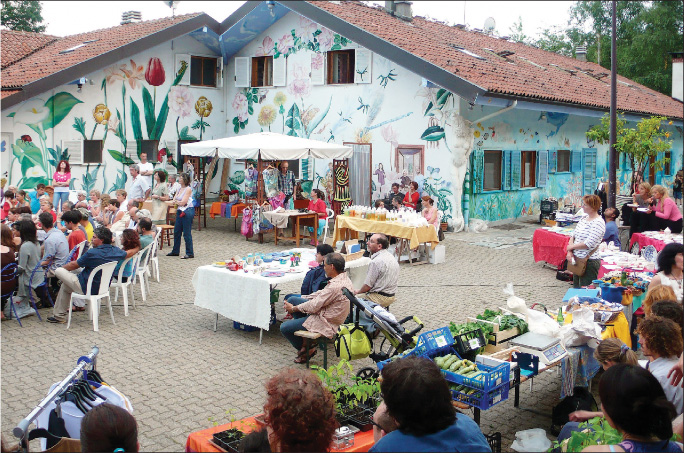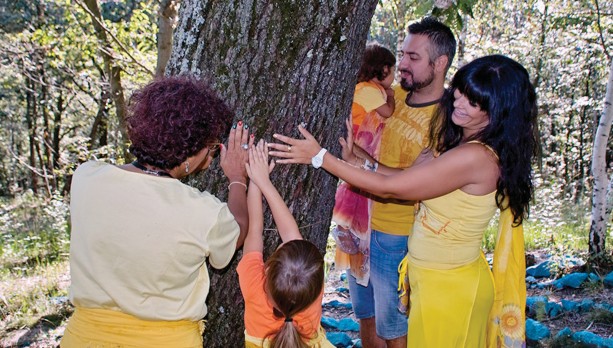Damanhur Italy
Deep contact with nature
by Macaco Tamerice
Damanhur is a Federation of spiritual Communities, nestled in the alpine foothills of northern Italy, in Piedmont, mainly in a beautiful green valley called Valchiusella. Damanhur is multilingual and very active, with its own constitution, culture, art, music, currency, school, environmental stewardship and use of science and technology. Many guests come to visit every year and Damanhurians are happy to share their experiences and research in many fields.
Damanhur’s philosophy is based on positive thinking, action and the idea that every individual desires to contribute to the evolution of humanity, through inner awareness and transformation. Our planet ‘Gaia’ is understood to be a sensitive being, to whom Damanhurians feel deeply connected, and environmental stewardship is a natural consequence.
Damanhur has slowly developed into a United Nations award-winning sustainable eco-community and is actively implementing many of the UN’s Sustainable Development Goals. The 600 resident citizens live in 25 different ‘Nucleo Communities’. They use the community as an opportunity for self-refinement, through exchange with others, positive thinking, embracing diversity and change, and pursuing common and personal dreams with a sense of humour and adventure. Everyday life is where philosophy comes alive in art, culture, family life, labour and politics and researching the subtle energies of the universe. In order to express the connection to nature, but also to emphasize change and humour, many Damanhurians choose to adopt an animal and plant name. So when you come and visit you might talk to Gazza Solidago (Magpie Solidago), Ornitorinco Platano (Platypus Plane Tree) or Condor Girasole (Condor Sunflower).
In Damanhur the contact with the forces of nature, guided by the desire to re-establish a harmonious relationship with life on our beautiful planet, has always been an active field of research. Damanhurians feel that humans are part of a spiritual ecosystem with forces and intelligences. It is important to establish a conscious contact with these, as it is with all life forms present in the environmental ecosystem that surrounds us. Our human evolution is inextricably linked to the reunification with the physical and subtle forces that inhabit our planet. Plants and nature spirits are inhabitants of our world, and a large part of the research in Damanhur is dedicated to experiencing a deep contact with them. Indeed one of Damanhur’s symbols is a flower, the dandelion.

Painters at work.

A child connecting with a plant.
The Music of Plants
The Music of the Plants research began at Damanhur in 1976, when resident researchers created an instrument that was able to capture the electromagnetic variations of the surface of plant leaves and roots, and turn them into sounds. The desire for deep contact with nature has also inspired the ‘Plant Concerts’, where musicians perform, accompanied by melodies created by trees. The trees learn to control their electrical emissions, so they can modulate the notes, as if they are aware of the music they are producing. This research has continued, and today, the device used for concerts is available to the public, so that this profound experience of plant world communication may be shared by anyone who wishes to do so.
At Damanhur, we believe that our planet is a living being to be respected and protected, as the concept of ‘Gaia’ expresses so well. In addition to cultivating a respect for nature, our ecological vision includes an awareness of how all of humanity is deeply connected with everything that surrounds us. These principles inspire the lives of Damanhurians, and they translate them into practical, everyday actions from renewable energy to organic farming and green building construction, to the community’s school system where children are taught to take care of the environment.

One of the Temples of Humankind.
The Temples
Damanhur is known worldwide for the Temples of Humankind, an underground work of art dedicated to harmony and beauty as an expression of free spirituality. They are a complex of eight halls adorned with remarkable paintings, mosaics, sculptures and glass art—all created to celebrate universal spirituality. The Temples were made with the ingenuity and creativity of Damanhurians, who worked together to excavate the rock of a mountain entirely by hand. It is an ‘impossible’ dream that awes and inspires thousands of visitors every year. The Temples are a stunning example of sacred and secular art coming together to resonate with values that are important to the whole of humanity.
A Federation of Communities
Damanhur’s social structure and political system have been changed many times over the years, from the first communities to the present Federation of Communities. The Damanhurian decision-making model has evolved, creating an efficient, democratic system, with representatives and elected bodies based on the participation of all citizens in public debate. Changes to the rules and regulations are ratified in accordance with the Constitution, which has been updated several times.
The aims of Damanhur are:
- The freedom and re-awakening of the human being as a divine, spiritual and material principle.
- The creation of a self-sustaining model of life based on ethical principles of good communal living and love.
- The harmonious integration and cooperation with all the forces linked to the evolution of humankind.


Different Communities in Damanhur.

The Constitution, the ethical charter of Damanhur, regulates the Social Body, which is formed by Damanhur’s citizens. The Constitution indicates the principles and aims of Damanhur and represents the red thread that runs through life here. There is a public ceremony on entering citizenship, when the new citizen makes a commitment to respect and apply the norms of the Constitution. There are different forms of citizenship, according to the choice and commitment of the individual. The Communities that are organized as a Federation represent the social network and are inspired by principles of solidarity and sharing. It is also possible for groups belonging to different schools of thought to affiliate with the Federation, if they are inspired by the same aims.
Out of the creation of shared tradition, culture, history and ethics, the popolo is born
The spiritual path, which we call the School of Meditation, leads every citizen through a lifelong process of self-exploration and search for the meaning of existence. This is facilitated through the study of ancient magical traditions and the celebration of the rhythms of nature. On this path, everyone learns to develop their talents and overcome their weak points.
In 2005, Damanhur received recognition from the United Nations Global Forum on Human Settlements as a model for a sustainable society. It was the result of Damanhur’s deep respect for the environment as a conscious, sensitive entity, and our citizens’ commitment to co-existing with the plant and animal worlds in a reverent and nurturing way. The choice to cultivate organic food and animal husbandry is a natural consequence of a deep respect for life, as is building according to green principles and using renewable energies. Some citizens have even created companies in such fields as renewable energy, eco-clothing and food production. Damanhurians prefer natural healing methods and a holistic approach to wellness, but not to the exclusion of science and medicine. It’s about appreciating life in all its forms and having the lowest possible impact on the environment. Where appropriate, cutting-edge technologies are used as a valuable ally in the defence of health and nature.

People of Damanhur.
Damanhur is communal property and all citizens participate in the management of it. Each Community is like a family, where those who work participate in covering costs supporting those in need, giving the capacity of supporting the projects of the Federation, such as the Damanhur School and the Temples of Humankind. Damanhurians created the Atalji housing association in order to have common ownership of all of the Federation’s property assets, both land and the Communities’ houses. This economic legacy has grown over time as Atalji has invested in acquiring new land and renovating old houses. Every citizen is a shareholder in the association and can withdraw their shares if they decide to leave. In addition, a cooperative called Punto Verde owns the facilities and land that is used for the community’s agricultural activities and livestock.
Damanhur has its own complementary currency called Credito as a new form of economics that is based on the values of cooperation and solidarity. Credito means credit and reminds us that money is a tool through which we grant trust, and represents a return to the original meaning of money as a means to facilitate exchange, based on agreements between those involved. In technical terms, the Credito is a functional account unit, active in a predetermined and predefined circuit. Today, the Credito has the same value as the Euro. All economic activities present in Damanhur provide for and favour the circulation of Credito as a system of internal exchange. Upon arrival at Damanhur, it is possible for all guests and friends to convert Euro currency.
Damanhurians have created businesses in the fields of arts and crafts, design, construction, renewable energy, nutrition, publishing and more, and many of these are located at the Crea centre. The common denominator among all Damanhur activities is the vision of work as a means of spiritual refinement. Work is a way to offer yourself to others, a way of expressing the creative dimension, and an opportunity to choose materials and processes with a low environmental impact.
In Damanhur, spirituality and community are completely linked. Community is a fractal of the wholeness of being, making each action a manifestation of spirituality.



Top to bottom: Connecting with a tree; Damanhur’s currency, the Credito; A map of Damanhur.
Location: Piedmont, Italy.
Established: 1975
Area: 500 ha (1,235 ac) Population: About 1000 people, 600 residents plus 400 people closely connected.
Housing: 25 nucleos = big houses, groups of houses
Common facilities: The Temples of Humankind, Sacred Wood Temple, Damanhur Crea meeting centre, guesthouse, coffee shop, sheds and barn.

One of SEKEM’s pupils during a music lesson.